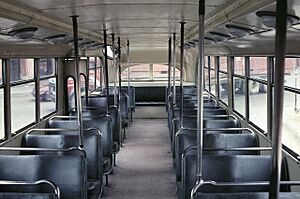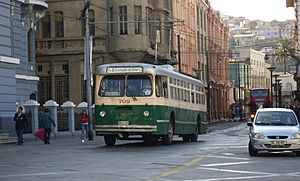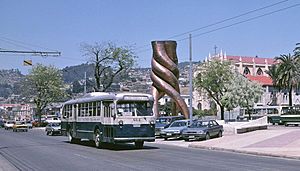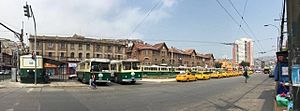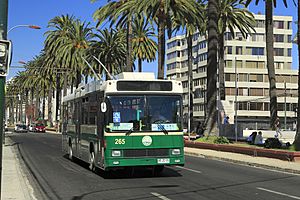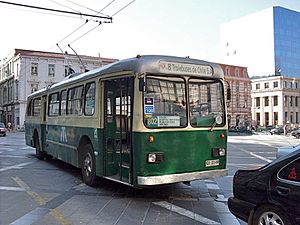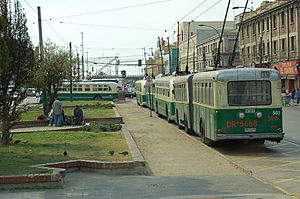Trolleybuses in Valparaíso facts for kids
Quick facts for kids Trolleybuses in Valparaíso |
|
|---|---|
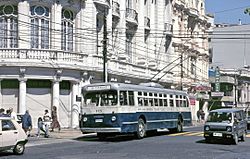
One of Valparaíso's 1952-built Pullman-Standard trolleybuses in 1996, when still in the system's original paint scheme and with the name of the private operating company, ECTE, along its sides
|
|
| Info | |
| Locale | Valparaíso, Chile |
| Transit type | trolleybus |
| Number of lines | 2 |
| Operation | |
| Began operation | 31 December 1952 |
| Operator(s) | Since 2007: Trolebuses de Chile, S.A. |
| Number of vehicles | 30 |
| Technical | |
| System length | Approx. 5 km (3 mi) |
| Electrification | 500–550 Volts DC |
The trolleybuses in Valparaíso, Chile, have been an important part of the city's public transport since 1952. This system is the second oldest of its kind in South America. It started as a government-owned service but became privately owned in 1982. Since 1994, it has been the only working trolleybus system in Chile.
What makes Valparaíso's trolleybuses special? Nearly half of them were built between 1946 and 1952 by the Pullman-Standard Company. These are the oldest trolleybuses still running regularly anywhere in the world! In 2003, the Chilean government declared them a national monument. They even helped Valparaíso become a UNESCO World Heritage Site. Many people see them as a "heritage sight" themselves.
In the early 1990s, the system bought several used trolleybuses from Swiss cities. Even these older vehicles became historic as they continued to operate for many years. For example, a trolleybus from Zürich built in 1959 was the oldest articulated (bendy) trolleybus in service worldwide for almost 20 years. Later, newer used Swiss trolleybuses from Lucerne replaced most of the older Swiss ones. Now, these newer Swiss trolleybuses make up more than half of the fleet, with the classic Pullman-Standard trolleybuses making up the rest.
The Valparaíso trolleybus system is a true symbol of the city. It's seen as a key part of its culture. Many locals, called porteños, love their unique and historic trolleybus service. They often speak up to protect it when it faces closure. The company that runs the trolleybuses does not get money from the government. This means it sometimes struggles financially, which puts the system at risk. In 2007, when the company announced it might close, citizens protested. Even Michelle Bachelet, who was Chile's president at the time, supported keeping the trolleybuses running.
Today, trolleybuses run on two routes, 801 and 802, from Monday to Saturday. They operate from about 7 a.m. to 10 p.m. There is no service on Sundays. Both routes connect the Barón area with Aduana. Route 801 uses Avenida Pedro Montt, and route 802 uses Avenida Colón. Each route is about 5 km (3 mi) long. The company Trolebuses de Chile, S.A. owns and runs the system. Locals often call the vehicles troles, which means "trolleys."
Contents
A Look Back: History of Valparaíso's Trolleybuses
Trolleybus service in Valparaíso began on December 31, 1952. It was Chile's second trolleybus system. The first one had opened in the capital city, Santiago, in 1947. The Santiago system closed in 1978, and a second one there only lasted from 1991 to 1994.
The trolleybuses took over from Valparaíso's last tram (streetcar) service. Trams had started in 1863, pulled by horses, and then became electric in 1904. The last tram ran on December 30, 1952. Trolleybus service began the next day, connecting Barón with Plaza Victoria. Just eight days later, the route extended to Aduana. The first route used Avenida Pedro Montt for its eastern part. A second route, using Avenida Colón, started in February 1953. Both routes shared the same western part. The Avenida Colón route is still in use today.
For many years, the government owned the trolleybus systems in Santiago and Valparaíso. The first operator was the Empresa Nacional de Transportes (ENT). This company had taken over the tram systems in both cities in 1945. In 1953, ENT became a new government agency called Empresa de Transportes Colectivos del Estado (ETCE). ETCE ran the system for the next 28 years. Both cities used trolleybuses made by the American company, Pullman-Standard. For Valparaíso, ENT bought 30 new trolleybuses from Pullman. These 30 vehicles were the very last trolleybuses Pullman ever built. They were made in late 1952.
ETCE's Santiago system had 100 Pullman trolleybuses. In 1954, ETCE moved 39 of these Santiago Pullmans to Valparaíso. These were used for a new 10 km (6.2-mile) route to Viña del Mar. This interurban service started in December 1959. However, it only lasted less than five years, ending by 1964. After that, trolleybuses only ran within Valparaíso.
After the 1973 military coup, the government reduced money for public transport. Both trolleybus systems quickly got worse. ETCE closed its Santiago trolleybus system in 1978. The remaining Santiago Pullman trolleybuses were sent to Valparaíso. Some were used for service, and others provided parts to keep the rest running.
The Valparaíso system struggled to keep its old vehicles and equipment working with little money. It eventually closed on November 30, 1981. But a group of local business people wanted to bring the trolleybus service back. They bought the old company's assets. On April 26, 1982, they formed a new company with the same initials: Empresa de Transportes Colectivos Eléctricos, Limitada (ETCE). Within two weeks, they had restarted the service using the same vehicles. Service continued on two routes, both connecting Barón with Aduana, either via Avenida Colón or Avenida Pedro Montt.
How the Fleet Changed Over Time
For almost 40 years, the fleet only had Pullman-Standard trolleybuses. These included the new 1952 Pullmans (700-series) and, from 1954, many former Santiago Pullmans (800-series). All of them used electrical parts from General Electric. By 1986, there were about 23–24 trolleybuses ready for service.
Between 1986 and 1989, ETCE rebuilt some of the 800-series vehicles. They gave them more modern front ends, and sometimes new sides and backs too. The older 700-series vehicles were not rebuilt.
Adding Swiss Trolleybuses
In 1989, ETCE planned to build a new trolleybus system in Santiago. To do this, and to add to its Valparaíso fleet, the company started buying used trolleybuses from cities in Switzerland. These vehicles were being replaced in their home cities, but they were still in good condition. They were 15–30 years old, but ETCE found them to be a cheap way to get more trolleybuses. The first ones were six articulated FBW trolleybuses from Zürich, built between 1959 and 1964. They arrived in Valparaíso in September 1991 and started service later that year.
By the end of 1992, ETCE had bought 31 used Swiss trolleybuses. They came from four different cities: Zürich, Geneva, St. Gallen, and Schaffhausen.
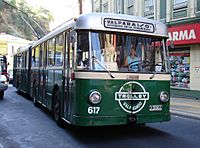
ETCE also heavily rebuilt 18 Pullman trolleybuses for the new Santiago system. These were renumbered 101–118. The Santiago system opened in December 1991, using four ex-Zürich vehicles and some of the rebuilt Pullmans. Soon after, eight brand-new Chinese "Shenfeng" trolleybuses from Norinco joined the Santiago fleet. These were the first Chinese-built trolleybuses ever sold outside of Asia.
Sharing Trolleybuses Between Cities
Most of the used Swiss vehicles stayed in Valparaíso. Some were used for parts. The three Schaffhausen vehicles always stayed in Valparaíso. A few of the ex-Geneva vehicles went to Santiago for a while, but later returned to Valparaíso. The Santiago fleet kept its four ex-Zürich and eight Shenfeng vehicles, plus the 18 rebuilt Pullmans.
The Santiago trolleybus system closed in July 1994. It struggled financially against other bus companies. Most of the Santiago fleet was stored, hoping to restart service, but it never did. In 1996, they were moved to Valparaíso.
After 1995
Most of the old Santiago fleet was eventually scrapped. A few Geneva trolleybuses that had run in Santiago started service in Valparaíso. Later, two Zürich vehicles (in 2003), one rebuilt Pullman (in 2004), and two Shenfengs (in 2004 and 2005) also started service in Valparaíso.
The five ex-St. Gallen trolleybuses did not work well in Valparaíso because the overhead-line voltage was lower. They were used only briefly and then stored. Most were scrapped in 2008, except for one (No. 142). This last St. Gallen vehicle was placed at the Barón terminus. It was changed inside to be a place to sell tickets and souvenirs, and for drivers and supervisors to use.
By 1992, only one of the older Pullmans (No. 814, built in 1947) was still in its original form and working. The company president decided to keep No. 814 original because it was a special heritage vehicle. It became the oldest unmodernized trolleybus still in regular service anywhere. Pullman 814 was damaged by fire in 2003, but ETCE repaired it. It returned to service and was still running regularly in 2017.
In July 2003, the 15 remaining Pullman-Standard trolleybuses (built 1946–1952) were officially named National Historic Monuments by the Chilean government. They are the oldest trolleybuses still running regularly anywhere. Valparaíso is also the only city in the world where Pullman-built trolleybuses still operate.
2010s: Trolleybuses from Lucerne
In March 2014, the current operator, Trolebuses de Chile SA (TCSA), bought ten used trolleybuses from the Lucerne trolleybus system in Switzerland. These vehicles were built in 1989 by NAW. They were much newer than most of Valparaíso's existing fleet. These were the first trolleybuses bought by the system since 1992. The first one arrived in June 2014, and the others followed by January 2015.
There was a delay in testing them because traffic rules did not allow such old transit vehicles to operate. TCSA's existing fleet had an exception. The rules were changed in early 2015, and testing began. The ex-Lucerne NAW trolleybuses started service in March 2015. TCSA later bought eight more of the same type from Lucerne. Four arrived in 2017 and started service that year. The final four arrived in late 2017.
Current Fleet of Trolleybuses
As of January 2019, the working fleet had 23 trolleybuses. The 18 newly acquired ex-Lucerne trolleybuses replaced all the older Swiss ones. In 2015, Pullman-Standard trolleybuses still made up more than half of the active fleet. But by 2019, only nine of the 23 active vehicles were Pullmans. In 2022, reports said that all Pullman-Standard trolleybuses were stored and only the ex-Lucerne NAW vehicles were running.
| Fleet numbers† | Manufacturer | Year built | Year rebuilt | Notes |
|---|---|---|---|---|
| 116 | Pullman | 1947 | 1991 | Was Santiago 820. Renumbered 116 in 1991, rebuilt for the second Santiago system. |
| 709, 714, 715, 721, 723 | Pullman | 1952 | n/a | Built new for Valparaíso, still have original bodies. No. 714 was retired in 2015. |
| 814 | Pullman | 1947 | n/a | Was Santiago 814. Still has its original body. Returned to service in August 2016 after repairs. |
| 801, 806, 821, 859 | Pullman | 1946–48 | (1987–89) | Was Santiago. Rebuilt on all four sides. |
| 802, 832, 888 | Pullman | 1946–48 | (1988–89) | Was Santiago. Rebuilt on front end only. |
Notes:
n/a = not applicable (vehicles not rebuilt, still in original form); "ex-Santiago" in this table refers to the 1947–78 trolleybus system there.
†: Bold typeface means the vehicle was active (in service) as of January 2019.
| Fleet numbers† | Manufacturer | Year built | Arrival in Chile |
Type | Date withdrawn from service, if applicable |
Former identity |
|---|---|---|---|---|---|---|
| 105 | FBW | 1959 | 1991 | articulated | May 2015 | Was Zürich 105 |
| 503 | FBW | 1963 | 1991 | articulated | Dec. 2016 | Was Zürich 129 |
| 504 | FBW | 1964 | 1991 | articulated | Feb. 2012 | Was Zürich 132 |
| 99, 612, 617 | Berna | 1965 | 1992 | articulated | 2013–15 | Was Geneva 99 (ex-607), 612, 617 |
| 102 | Berna | 1966 | 1992 | articulated | late 2009 | Was Schaffhausen 102 |
| 203 | Berna | 1966 | 1992 | two-axle | May 2017 | Was Schaffhausen 203 |
| 603 | Shenfeng | 1991 | 1991 | two-axle | 2014 | Was Santiago (ETS) 603 in 1991–1994 |
| 607 | Shenfeng | 1991 | 1991 | two-axle | October 2016 | Was Santiago (ETS) 607 in 1991–1994 |
| 252, 260, 261, 262, 263, 264, 265, 266, 268–270, 272–276, 278, 279 |
NAW | 1989 | 2014–17 | two-axle | in service | Was Lucerne, same numbers |
Note †: Bold typeface means the vehicle was active (in service) as of January 2019.
Of the last three active ex-Geneva trolleybuses, No. 612 was retired after a crash in 2010. By late 2014, Nos. 617 and 099 were out of service due to problems. Ex-Zurich FBW No. 504 was retired after a fire in 2012. After the 10 ex-Lucerne NAW trolleybuses started service in 2015, the last two Geneva vehicles (617 and 099) were permanently retired. Shenfeng trolleybuses 603 and 607 were also retired, though 607 returned to service in December 2015. Ex-Schaffhausen 203, the last of the older Swiss trolleybuses from the 1960s, was finally retired in May 2017.
Changes to Service After 1990
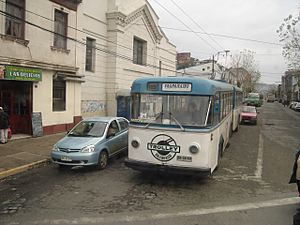
The Avenida Pedro Montt route stopped running in 1991. This left only the Avenida Colón route in service. ETCE tried to bring back the Pedro Montt service twice, in 2002 and 2007. But they stopped it again after a few months each time. This was because other bus companies on the same street made it hard for ETCE to make money.
A new company called Trolebuses de Chile, S.A. (TCSA) was created in 2000. ETCE still owned and operated the system, but some parts, like the overhead wires, were moved to the new company. In August 2002, service stopped for three weeks because of a drivers' strike. About 20,000 people signed a petition asking for the trolleybus service to return. The city's biggest newspaper, El Mercurio, also wrote an article supporting the trolleybuses.
Trolebuses de Chile, S.A. became the main operator of the trolleybus system in early 2007.
Big Changes in 2007
The trolleybus system saw several changes in early 2007. This was part of a new regional transport plan called Plan de Transporte Metropolitano Valparaíso (TMV). TCSA brought back the Avenida Pedro Montt route in January. The government gave the company special rights to provide service on that street. The company's two routes were then numbered 801 (Pedro Montt) and 802 (Colón). Before this, they had no numbers. The TMV also required all transit vehicles to have a uniform paint scheme. TCSA's trolleybuses had to be repainted green and cream by April 2007. Before this, some used Swiss trolleybuses still had their original colors, and some had advertisements. These were no longer allowed. The company also started Sunday service for the first time, beginning in January 2007.
At first, TCSA reported a big increase in money because of its near-monopoly on Avenida Pedro Montt. But this changed quickly. Merchants on the street complained, and the government allowed 16 other bus routes to return to Avenida Montt just three weeks later. The trolleybus company's income dropped sharply. It had just spent money repainting its fleet and expanding service. So, in May, the company announced the system would close in mid-June.
This news upset many citizens. The old trolleybuses, declared a national historic monument in 2003, were a beloved local symbol. Even Michelle Bachelet, Chile's president, said, "The trolleys can't stop running in Valparaíso." Talks between TCSA and government officials led to agreements that stopped the closure. Service continued on the Avenida Colón route (802). But the recently revived Avenida Pedro Montt service (route 801) was stopped again around September 2007.
On October 31, 2007, the "historic monument" status for the Pullman-Standard trolleybuses was expanded. It now included most of the system's equipment, like overhead wires, support poles, and substations.
On May 4, 2021, route 801 was brought back into operation after almost 14 years.
Where Trolleybuses are Kept and Fixed
During the 2007 crisis, officials promised to help TCSA find a better place for its garage. Until 2000, the trolleybuses were kept at the city's old tram depot. But the city sold this property in 2000 for new development. ETCE had to find another place for its fleet. They couldn't find a suitable indoor place near their route. For several years, the trolleybuses were mostly parked on city streets, even overnight. All maintenance work had to be done outdoors.
In mid-2008, TCSA started renting a building only 90 m (300 ft) from its route. This became its new depot. For the first time in eight years, most of the trolleybus fleet could be kept indoors at night. They also had indoor facilities for maintenance.
The trolleybus system was not badly damaged by the 2010 earthquake. Service stopped for two days while all the route's equipment was checked for damage.
TCSA started a summer-only city-tour service in January 2010. They used one of their historic 1948-built Pullman trolleybuses for this. It ran in January and February 2010 and returned for a second season in January 2011.
See also
 In Spanish: Trolebuses de Valparaíso para niños
In Spanish: Trolebuses de Valparaíso para niños
- Funicular railways of Valparaíso
- Valparaíso Metro


